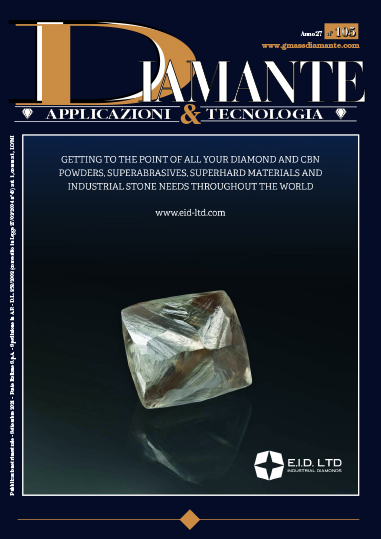|
Diamante A&T Contents Year XXVII - September 2021 |
|||||
|
Front Cover: EID LTD For more than 50 years EID has been providing the widest array of top quality industrial diamond stones, natural and synthetic diamond powders to the trade. In the Spotlight 12) TESIMAGV, valuable know-how 14) 25th POLIGEM anniversary. A singular trait d'union between an intense past and a surprising future Grinding 30) Grinding of aerospace materials used for high-temperature applications by K.P. Varghese, J. Hagan, A. BiroSaint-Gobain Abrasives, Northboro, Massachusetts, USA
Abstract: Many aerospace components used in the high and low pressure sections of a turbine engine are made from materials
such as high nickel-based super alloys, intermetallics such as gamma titanium aluminide and ceramic matrix composites. These components that may be cast, forged or sintered using
powder metallurgy techniques, are notorious for being difficult to machine due to their high strength, toughness, corrosion and fatigue resistance, and low thermal conductivity.
Many of these parts have as much as two-thirds of their original weight removed to produce the finished component. Traditionally turning, milling and broaching processes are
employed to remove most or all of the material from these components. However, with the use of modern grinding wheels composed of engineered grains and high strength bond
technology, grinding can now remove the material more quickly and economically than turning or milling. This paper will show data/results of surface grinding and creep
feed grinding tests conducted on advanced aerospace engine materials specifically gamma titanium aluminide, IN718 using both conventional and superabrasive grinding wheels.
It will also compare the grinding of ceramic matrix composites with that of monolithic ceramics. Raw Materials 49) Electropolishing in ecofriendly solution of Ti6Al4V parts produced by Electron Beam Melting by A. Acquesta, T. Monetta, Department of chemical, materials and production engineering, University of Naples Federico II, Naples, Italy
Abstract: The additive manufacturing process is gaining increasing interest due to the possibility of producing components with a complex shape, very close to the final geometry. On the other hand, however, it involves a very high
final roughness, such as to compromise the mechanical performance and resistance to corrosion. Therefore, post-processing treatments are required. Electropolishing could be the ideal treatment to reduce the
roughness of these components. It is known that various parameters, such as the type of electrolyte solution, the voltage or current applied, the treatment time, agitation, etc. They could affect the effectiveness of the electropolishing
treatment. The most commonly used electrolyte solutions are dangerous to handle and difficult and expensive to dispose of. The aim of this work was to study a possible electropolishing treatment on Ti6Al4V samples made by
Electron Beam Melting (EBM) using an "eco-friendly" electrolytic solution. Sintering 56) High temperature sintering of low alloy steels: effect on shrinkage and dimensional stability by D. Toledo, I. Cristofolini, A. Molinari, V. Arnhold, V. Kruzhanov, P. Vervoort, M. Dougan, L. Wimbert, V. Bonnefoy, R. Hellein, H. Weber, F. Baumgartner, M. Fernandez, C. Larsson, M. Schneider
Abstract: The influence of high temperature sintering on the dimensional stability and the microstructural and mechanical properties
of some low alloyed steels was investigated in the EPMA Club Project "HTS". The materials investigated were five different powders: Ancorsteel 4300 and FeSiVC (Hoeganaes Corporation grades),
AstaloyCrM, AstaloyCrA+2%Ni and DistaloyAE (Höganäs AB grades). Rings (55 mm external diameter, 45 mm internal diameter, 5 mm height) were cold compacted and sintered
at the standard temperature of 1120°C and at high temperature in the 1180-1260°C range in different continuous furnaces. The whole manufacturing process was carried out in industrial
plants. In spite of the larger shrinkage than at 1120°C, high temperature sintering does not impair the dimensional precision and stability of the rings.
HTS processing widens the possibilities for new alloy systems in industrial applications with opportunities to reduce cost and achieve improvements related to processing (REACH). News and Events 68) Marmomac 2021 celebrates the return of attendance in person with a brand new communication campaign 70) Third edition of Rocalia from 30th November to 2nd December 2021 |
|||||

